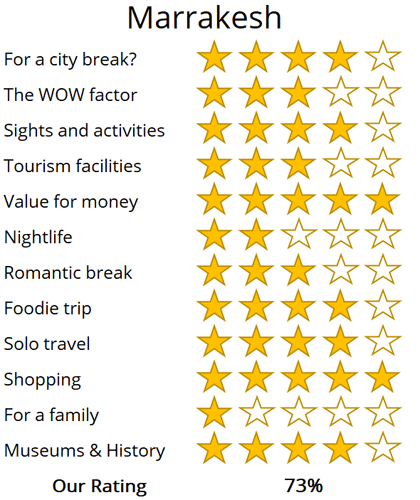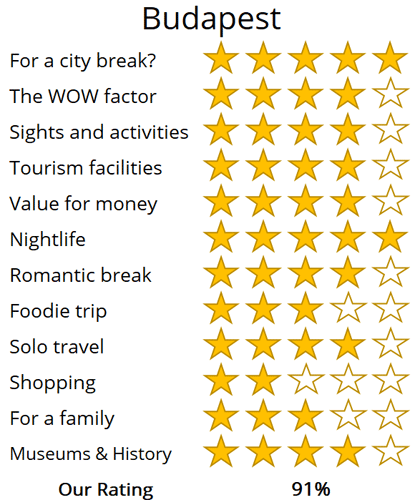WhereToGoForMyHoliday.com
The best destination comparison site!
WhereToGoForMyHoliday.com
The best destination comparison site!
Marrakesh or Budapest, which is better for your holiday in 2024?
Marrakesh and Budapest both offer unique and enticing experiences, but which one should you choose for your city break or holiday?
We understand your dilemma. There is an abundance of travel guides for both cities, but few actually comparing them, and advising you which is the better for your trip.
This article will provide our unbiased and independent views of Budapest and Marrakesh, hopefully making your choice that little easier.
The article is structured into several sections, each of which can be directly accessed through the following links:
• Introduction to the cities
• Scores and ratings
• Which one should I, friends, or family visit?
• When to visit and weather
• Who is the city suited for?
• The perfect 48hours (with map)
• Tourism details (where to stay? airport details?)
Introduction to Marrakesh and Budapest
Mystical and magical, Marrakesh could have been plucked from One Thousand and One Nights. A city of souks and madrassahs, it will enthrall with its spice markets, lantern bazaars, pottery hawkers, carpet stalls – the list goes on.
All that resides in the throbbing medina area, anchored on Jemaa el-Fnaa square, where you'll dodge snake charmers, fortune tellers, monkey tamers, and dance troupes come the evening.
Around the medieval centre of town is a sprawling modern city. Neighborhoods there come in the form of stylish Gueliz, with its Parisian-influenced boulevards and palm-lined streets. There's also the Jardin Majorelle, where the designer Yves Saint-Laurent has wrought the cacti plumes and the ponds into something truly special.
These days, loads of low-cost carriers can whiz you over to Marrakesh from Europe, opening this hitherto hard-to-reach city to travellers looking for a break with a difference.

Marrakesh will steal your senses….
Straddling the snaking Danube in the very heart of Europe is Budapest, the buzzing capital of Hungary.
Here, a city of two halves – Buda and Pest – unites to form a complex tapestry of over 1.7 million lives. With grand 19th-century bridges stitching together the landscape, Budapest entices with its blend of storied history, striking architecture, café charm, and lively nightspots.
Whether your eyes are drawn to the regal palaces atop Buda Hill or the heady aroma of sulphur from steaming bathhouses, Budapest never ceases to captivate. Venture into ruin bars, gaze upon the monumental Dohány Street Synagogue, or stroll the wide boulevards left behind by the Communist era.
In Budapest, every glance reveals a new layer of intrigue, a city where the past and present are locked in an endless dance.
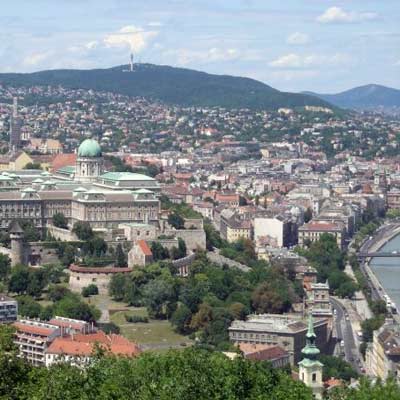
Budapest is a vibrant and modern city just waiting to be explored

The skyline of the Marrakesh with the Atlas Mountains covered in snow in the distance
Marrakesh vs Budapest: City Ratings
Summary
Where would I journey for a personal escape?
Budapest
Where would I send my parents for a memorable visit?
Budapest
Where's the ideal destination for my adventurous 19-year-old cousin?
Budapest
Where should my food-obsessed friend indulge their culinary passions?
Budapest
Note: The above comparisons are weather-independent and are based on travel during the most opportune times of the year. Details about the ideal travel seasons are elaborated upon later in this article.
In the sections that follow, you'll find a comprehensive comparison between these two fascinating cities. This includes recommendations on the duration of stay, the best times to visit, and tailored 48-hour itineraries for each city.
The final segment delves into practicalities for your travels, such as the best airport to fly into, the optimal districts for your accommodation, and insider tips, for when you come to explore the city.
We hope that you find all of this information useful, in planning your next exciting trip!
Destination details
How long to spend each city?
Fly-in visits for three days are enough to check off the major must-see sights of Budapest. This is a compact capital with good underground and bus links. You can get easily get across town – going from Buda Castle on one side of the city all the way to the Széchenyi Thermal Baths at the other takes less than an hour on public transport.
That said, Budapest has plenty of hidden secrets up its sleeve. You could easily while away a whole week enjoying cheap happy hours in the ruin bars, bathing in the Art Deco spas, and visiting islands up the Danube. If you're coming in summer, you could also extend a stay to include the art galleries and cobbled lanes of Szentendre, the mineral-rich waters of Lake Balaton, and the rustic Tokaj wine country to the east.
Two or three days is usually enough to get a good feel for the character and charms of Marrakesh.
In fact, lots of travellers say that any more than that is downright exhausting. That's because the touts and hawkers in the bazaars don't ever give up, and there's not much of a conception of personal space.
Still, 48 hours or so shouldn't be too overwhelming. And it will be plenty to check off the medina, the Majorelle Garden, stoic Koutoubia Mosque, and the lovely parks, all while having enough time to enjoy the enchanting riad hotels offered by this corner of the world.
Lots of travellers will be tempted to stay longer by the promise of the Atlas Mountains that loom on the horizon. If you can, a jaunt to those is definitely a good idea. It's a bus of a few hours up to the trekking hub of Imlil. From there, you can get a guide to navigate some gorgeous trails, and even climb the highest peak in North Africa (Mount Toubkal at 4,167 metres).
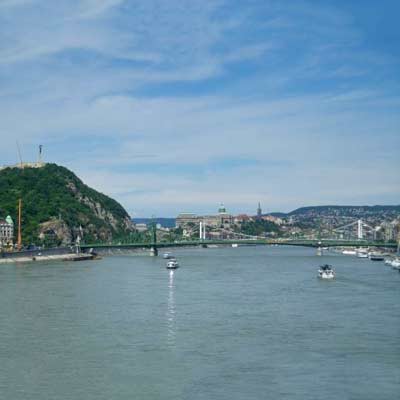
The mighty Danube River cuts Budapest in two
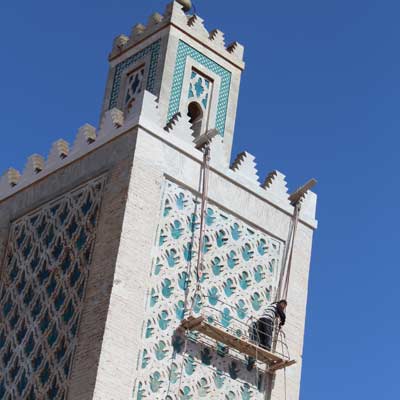
Cleaning the Kutubiyya Mosque tower, Marrakesh
It's no secret that Morocco gets hot. In fact, the summertime here can see temperatures exceed 40 degrees on a regular basis. That's not good for sightseeing and walking around. In fact, it can be downright exhausting. What's more, the crowds spike in Marrakesh between July and August, as holidaymakers flock in, even despite the soaring mercury levels.
Much better options are spring, in April, and autumn, in October. They have average highs in the upper 20s, and hardly a drop of rainfall. It's probably wise to avoid Ramadan dates, however, because that can affect transport and hotel services. Marrakesh also offers winter sun. Drop in between November and March to find average warmth of 18 degrees and clear blue skies. Evenings can be cool then, so a jumper is advisable.
Late spring and early autumn are when locals often say Budapest is at its best. Temperatures average around 23-25 degrees in May and September. There's not an overload of rain then either. And it's perfect for avoiding the crowds of midsummer city breakers that come during the European holidays.
There's also something to be said for visiting Budapest in the midst of winter. Mercury plummets between November and March, and it's not uncommon to see the Danube freeze over with huge chunks of ice. What's more, the tenements and side streets of the Jewish Quarter and the historic Inner City areas ooze atmosphere on cold, snowy days. Just be sure to pack the thermals!
Budapest, with its rich historical culture, intertwined seamlessly with an energetic nightlife, has established it as a top destination for a diverse range of travellers. Backpackers gravitate towards the Jewish Quarter's unique ruin bars, where they can indulge in exceptionally affordable Hungarian beers amidst eclectic courtyards.
Meanwhile, those with a cultural focus may choose to delve into the history of the Hungarian empire at Buda Castle or pay homage at the poignant House of Terror museum, which delves into the oppressive Stasi era.
However, if your preference leans towards sun-soaked beaches, Budapest might not feel like a perfect fit. Situated in a landlocked region, both the city and the country are devoid of coastline. Furthermore, while there are parks, they are predominantly located on the city's periphery, making Budapest predominantly an urban experience.
Feeling adventurous? Then, yes – Marrakesh is for you! An amazing place of spice smells and pandemonius markets, it's nothing like the cities you find on mainland Europe. You'll be hassled at every corner.
You'll dodge donkeys and hurtling minibuses. You'll encounter strange snake charmers and magicians. But all that is part of the fun, and what makes this Moroccan jewel the perfect place to break away from the comfort zone.
There's also something of a luxurious edge to Marrakesh. If you're willing to fork out for a hotel, then you can bag some seriously plush places, whether it's an inner-city riad with flower-filled courtyards or an oasis resort with infinity pools overlooking the Atlas Mountains.

The Jamaa el Fna market square at sunset
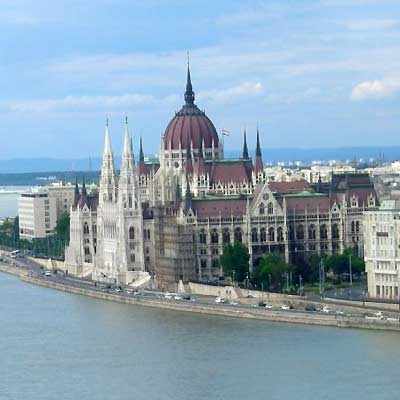
The Hungarian Parliament stands as a stunning testament to Budapest's architectural grandeur, holding the title of the city's tallest building
48hours in Budapest
Day 1: Begin your journey on the Pest side of the city, where the magnificent Dohány Street Synagogue resides. This landmark is not only pivotal to Budapest but also stands as the largest synagogue in Europe. Following this, take a stroll along Andrássy Avenue, a grand boulevard and UNESCO World Heritage site, adorned with Neo-Classical mansions.
Delve into Hungary’s tumultuous history with a visit to the House of Terror museum, situated at one end of the avenue. Subsequently, unwind with a spa session at the renowned Széchenyi Baths, celebrated for its Art Deco architecture. Cap off the day with a hearty dinner at Gettó Gulyás, indulging in their signature paprika-smoked goulash, and conclude your evening with a drink at Szimpla Kert, a mesmerizing art gallery turned bar.
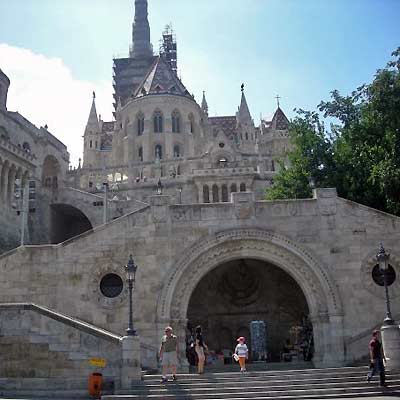
Pest cathedral
Day 2: Start your day with breakfast at the historic Central Market Hall, established in 1897. Savour the taste of sweet Hungarian pastries before crossing the Danube via the striking Liberty Bridge.
Upon arrival, you have the option to visit the elegant Gellért Baths or continue your journey to the Fisherman's Bastion and the Citadella, former military strongholds that now offer breathtaking views of the Danube. A northward stroll leads you to the Castle District, where you can either admire the architecture from the outside or explore the regal court rooms inside.
Don’t miss the chance to capture some photos of the imposing Hungarian Parliament Building across the river. Conclude your day with dinner in the Inner City of Pest, offering a diverse range of dining options from Tex-Mex restaurants to atmospheric 1930s speakeasies.

Gellért Hill offers some of the best views of Budapest, the hill is named after Saint Gerard who was murdered in 1065 by being put in a barrel and rolled down the hill…
Follow this fun-filled itinerary to make the most of your trip to Marrakesh. In just 48 hours, it packs in broiling tagines and stunning mosques, not to mention walks through the famous souks.
Day 1: Dive straight into the souks. Frantic and fun, these are the lifeblood of Marrakesh; ancient marketplaces where Berbers and spice traders once plied their trade. Things are now a little more tourist orientated. Head to D.El Maâden street and you'll find handcrafted leather bags and sandals.
Coming off that is the souk of the Babouches, where tanned slippers burst from every cobbler shop. You can then move to Souk Chouari to find whittled trinkets and statues in the carpenter's quarter. Still going north, you soon come to Souk des Teinturiers, where the pungent smells of tanning chemicals herald the leathermaker's market.
Double back and walk past Cafe Árabe to refresh with some mint tea and biscuits. Then it's into the heart of the medina, where the hubbub of Souk Semmarine unfolds with lantern shops, pastry vendors, and sparkling gold jewellery. Also be sure to breeze through the fragrant Souk Et Attarin, stacked with colourful soaps and all sorts of healing herbs.
Southwards brings you along Kennaria dabachi street, home to the veggie-friendly Corner Café and its falafel pitas (a great lunch). South again and you'll hit the Bahia Palace.
A whopping 160 rooms fronting vast courtyards and palm-topped gardens awaits there – a glimpse onto the grand old age of the viziers back in the 1800s. For dinner, return to the souks to find loads of spots selling aromatic tagines in traditional clay pots.
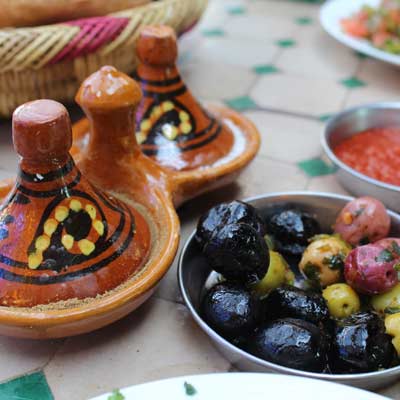
Expect delicious food while in Morocco
Day 2: Don't be tempted by the allure of the bazaars right away. The other – more modern – half of Marrakesh awaits on day two. Find that to the west and north of the medina, holding the secret Majorelle Garden. This is unquestionably one of the city's (and all of Morocco's) most enchanting attractions.
A pleasure park that has been landscaped and curated by, among others, the French fashion designer Yves Saint-Laurent, it hosts a vivid blue villa and ponds peppered with lily pads. Beyond is the district of Gueliz. That was built in the image of France, so expect wide boulevards and chic café-bakeries, along with classy clothes stores and bistros.
For lunch, the quiet Cyber Park is a great place for a picnic. It's got babbling fountains and benches in the shade of date palms, all framed by the snow-capped Atlas Mountains. It's also a short walk from there to Jemaa el-Fnaa – the great plaza in the middle of the city.
Arrive in the early evening and you'll see entertainers of all sorts. Curious dancers, mystics speaking in tongues, the infamous snake charmers – they all make an appearance. To the side is the wonderful Koutoubia mosque, which looks especially handsome during sunset.
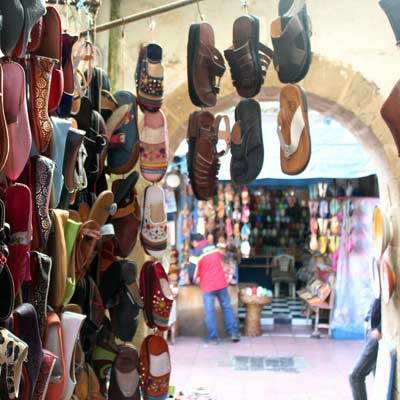
The colourful markets of Marrakesh

Majorelle Gardens
Marrakesh
Marrakesh Menara Airport sits just to the west of the heart of the city. It's now a major arrival point for low-cost carriers coming out of Europe, but also has premium flag-carrying airlines and domestic services coming into its runways. The distance from terminal to souk is just three miles.
However, you'll need to push a hard bargain with the taxi drivers outside for even that short journey – they're renowned for their scams and inflated prices. A fair rate is around 40-50 MAD. There's also a bus. Look for the No 19 Airport Express costing 30 MAD with a free return included if you make the trip within a fortnight.
You'll certainly need to have your wits about you in Marrakesh. Unlike any European city, it's hectic and in-your-face. There's always someone trying to sell you something or hassle you into taking a tour.
A simple 'no' and a determined walk past them is usually enough to shake off the attention. Always haggle for taxis and goods but try to keep the bartering light-hearted and fair. It's also best not to walk through the Guéliz district after dark – it's known for being the riskier area.
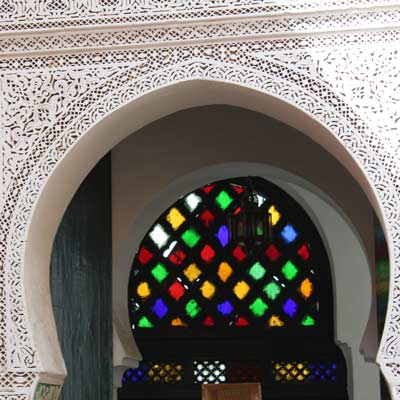
Beautiful Islamic art in Marrakesh
Hotel wise, there's really nothing like a classic Moroccan riad. In fact, we'd go as far as to say don't book anything else in Marrakesh. They're old, Berber mansions that are centred on a tiled courtyard that either has a babbling fountain or a small splash pool.
You can pay less and get a more traditional one, but the luxurious riads are an experience in themselves. They typically exist in the medina area and on its fringes.
Travelling to and around Budapest is super easy. There's an efficient underground network. Tickets for that cost 350 HUF per ride with a single transfer allowed. You can also use river boats (HUF750 per journey) and buses (350 HUF).
Taxis are rarely needed, but they are cheap, costing 280 HUF per kilometer. Be sure to insist your driver puts the meter on, and never accept offers from taxi touts at the airport.

The Fisherman's Bastion, Budapest
Talking of the airport, Budapest Airport sits around 22 kilometers from the city center. You can get to and from the terminals using the dedicated express bus (€2) or by train (€2.70). Both options take between 30-40 minutes. Be sure to buy tickets at machines by the stops – they're more expensive when purchased direct from drivers.
When it comes to picking hotels in Budapest, you're best off focussing on the Pest side of the city. That's where the bulk of the best lodgings are located. Being in the Jewish Quarter can be noisy, but perfect if you want to hit the nightlife of Szimpla and the other ruin bars. The Inner City area is charming and quieter, with some boutique options. Meanwhile, Újlipótváros is a local's favourite, with its cool cafés and art galleries and sleek Airbnbs.
Related articles: Where to stay in Budapest
Budapest is largely safe and crime statistics are in line with European norms. Some well-known scams include taxi drivers who overcharge and sellers of fake goods. Pickpocketing is also a rare but real problem. Just be aware of your personal possessions and be vigilante, especially when on public transportation.
Price wise, Budapest is surely up there with the cheapest of European capitals. A large beer can cost as little as 500 HUF (€1.50). Food in a midrange restaurant will set you back between 2,000 HUF and 3,000 HUF (€6-9). Nights in hotels are noticeably less than in nearby Vienna, too.

oh we were stuck in the airport!

Copenhagen was a bit expensive...

All we did was drink beer in Brussels...

Muncih was crazy

And we got so burnt!

Remeber that night in Rome

oh we were stuck in the airport

So much fun kayaking

Berlin and that group from Austria!

There was such a view from that church

And we got so burnt!

Munich was eventful, wasn't it!

Such a view from that cathedral in Florence

Lisbon was such so much fun

Last summer was so much fun .... x

Remeber that night in Rome

Lisbon was such so much fun

Such a view from that cathedral in Florence

Munich was eventful, wasn't it!

And we got so burnt!

Remeber that night in Rome

All we did was drink beer in Brussels...

Berlin and that group from Austria!

Can't wait to go back to Dubrovnik

Remember that boat ride in Prague

Copenhagen was a bit expensive...
